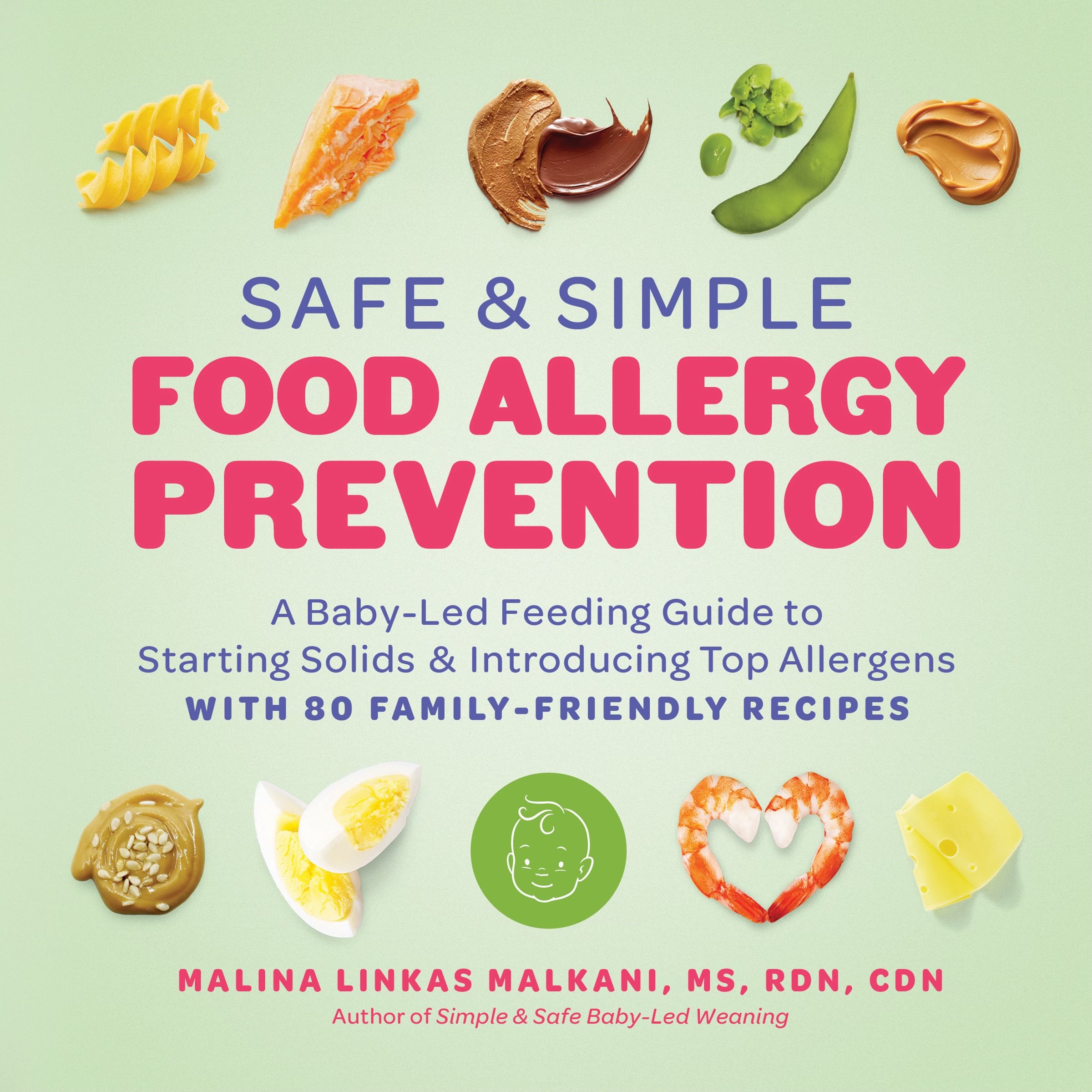How To Introduce Peanut Butter to Baby
This blog contains affiliate links, meaning that if you choose to purchase a product through a link, I will receive a small commission - this in no way impacts the amount you pay. Affiliate links are marked with an asterisk (*).
As you invite your baby into the world of solid foods, introducing a variety of flavors, textures, and foods is key for their development. One nutritional powerhouse that becomes the subject of a lot of questions during this phase is peanut butter.
Packed with essential nutrients and healthy fats, peanut butter can be an excellent addition to your baby's diet AND offering it early and often helps prevent peanut allergies, but many parents may need clarification about how and when to introduce allergic foods like peanuts to their babies.
As a pediatric dietitian specializing in infant feeding, my goal with this blog post is to guide you through the steps of introducing peanut butter to your baby while addressing questions and concerns about food allergy prevention and potential allergic reactions.
What is a food allergy?
According to the American College of Allergy, Asthma, and Immunology (ACAAI), an IgE-mediated food allergy occurs when the body’s natural defenses overreact to a particular substance, treating it as an invader and sending out chemicals to defend against it.
An IgE-mediated food allergic response occurs almost immediately (usually within 10 minutes or less) after eating the offending food allergen and occurs every time the food is ingested – it is different from a food sensitivity or intolerance, which involves other parts of the immune system.
Eight foods are responsible for about 90 percent of all food allergies. Sesame was recently added to the list of top allergens in the U.S. that must be declared on U.S. product labels. This list of the top nine allergens includes cow’s milk, eggs, fish, crustacean shellfish, tree nuts, peanuts, wheat, soy, and now sesame.
Food allergies are relatively common, with 1 in 10 adults and almost 1 in 13 kids having at least one. Most babies are not born with food allergies (which develop over time), and there is currently no cure for food allergies, but thankfully, we now have effective research like the LEAP Trial, which shows that we can reduce the risk of the development of peanut allergies during infancy in the way we feed babies.
When can low-risk babies have peanut butter?
The American Academy of Pediatrics used to recommend waiting until a child was between 1-3 years old to introduce common food allergens like peanut butter; however, in the last two decades, new research has emerged, showing that early introduction of potential allergens, including peanuts, to babies between 4 and 6 months of age may help reduce the risk of developing allergies later in life.
Once a baby is around 6 months of age, showing signs of readiness for solids, and successfully eating a few non-top-allergenic foods, caregivers should offer smooth peanut butter in baby-safe forms. According to the American Academy of Pediatrics, babies without eczema or other food allergies, who are not at increased risk for developing an allergy may start having peanut-containing foods after a few solid foods have been introduced at around 6 months of age.
As with all baby foods, providing developmentally appropriate and safe serving sizes is important.
When can high-risk babies have peanut butter?
The strongest risk factor for food allergies is severe eczema (or atopic dermatitis). The second major risk factor is an existing egg allergy.
According to the National Institute of Allergy and Infectious Disease Guidelines (NIAID), the updated guideline for babies with one or both major risk factors for peanut allergy is to introduce peanuts as early as 4 to 6 months of age.
In the U.S., the expert panel recommends considering allergy testing first in a pediatrician or allergist's office with a specific blood test called a peanut-specific IgE measurement. It may also be beneficial to perform a skin-prick test or oral food challenge in the presence of an allergist or other healthcare professional; however, if an appointment is not available early on, it is not recommended to delay past 4-6 months of age.
It’s also important to note that the scientific community is not in agreement about pre-screening prior to peanut exposure and that guidelines from other countries and organizations don’t require it as a matter of routine.
For infants with mild to moderate eczema, the panel recommends introducing peanut-containing foods at around 6 months of age.
Once the baby has been exposed to peanut-containing foods without any signs of allergy, it is important to continue offering peanut products and foods consistently and frequently (about 2 teaspoons of peanut butter, 2-3x per week) to help reduce the risk of peanut allergy.
A sweet 10-month old baby boy enjoying peanut butter toast! Thank you to his parents for sharing.
Best Peanut Butter for Babies
When introducing peanut butter to your baby, opt for smooth, unsalted, and unsweetened varieties, such as Justin’s No-Stir Peanut Butter*. Check the ingredient label - my favorite options are those made without hydrogenated oils that contain only peanuts (and maybe a little salt.) Prioritize peanut butter that doesn’t contain added sugars, oils, or artificial additives, but know that it’s more important to expose babies to peanut butter or peanut foods early and often in whatever baby-safe form is available, rather than wait until you find a “perfect” brand.
Can I Give My Baby Peanut Powder?
Peanut powders* are a convenient way to introduce peanuts to your baby's diet. They offer many of the same nutritional benefits as peanut butter but in a finely ground form that is easy for babies to consume. Additionally, peanut powders can be mixed into a variety of dishes, such as yogurt, smoothies, soups, and baked goods.
How to Introduce Peanut Butter to Babies
Whole nuts and globs of peanut butter are a choking hazard, so it’s important to modify peanut foods before serving them to a baby. Here are some tips on how to prepare peanut foods for your baby and how to introduce them for the first time.
1. Choose a time of day when your baby is well-rested, healthy, happy, and alert and when you can be fully attentive for at least 2 hours, such as after a morning nap (babies also tend to be more receptive to new tastes during this time)
2. Prepare a portion of peanut-containing food for your baby by mixing 2 teaspoons of smooth peanut butter or peanut flour with breast milk, formula, or a familiar fruit puree
3. On the tip of a spoon, offer a tiny amount (about ¼ of a teaspoon)
** Never give your baby a large glob of peanut butter, as this can be hard to swallow and can be a choking hazard for your baby!
4. Wait 10 minutes and observe your baby for any signs of an allergic reaction, such as rash, hives, vomiting, diarrhea, or difficulty breathing
** If you notice any unusual symptoms, contact your pediatrician or call 911 immediately
5. If no reaction, continue to feed as much of the remaining portion as your baby seems to want and continue monitoring your baby for another 2 hours
6. Then work up to serving your baby 2 teaspoons of smooth peanut butter or peanut flour 2-3 times per week going forward as their feeding skills and appetites increase
7. For more tips on offering peanut foods, check out this handout from the NIAID
Top Ways to Serve Peanut Butter to Babies
Spread in a thin layer on whole-grain toast strips
Mixed into oatmeal, pureed vegetables/fruits, or applesauce
Serve these delicious Mascarpone Peanut Butter Melts (best for babies using a pincer grasp which usually emerges closer to 9 months)
Offer strips of these tasty Peanut Apple Fritters
Signs of Food Allergy to Peanuts
If your child is at high risk for food allergies, talk to your healthcare clinician about a plan for allergen introduction. If any of the signs and symptoms below are true about your baby or child, your healthcare provider should consider the diagnosis of food allergy and refer you to an allergist:
Peanut Butter Banana Mash
Your child experiences hives or vomiting (the two most common signs of food allergy in infants) after eating peanut butter
Your child experiences anaphylaxis after eating peanut butter puffs or another peanut-containing food (or a severe allergic reaction in response to a food that involves more than one body system, i.e., the skin, the respiratory system, and/or the gastrointestinal tract)
Your child experiences multiple food-allergic symptoms within minutes to hours of eating peanut-containing foods
Your child experiences any signs of an allergic reaction after ingesting peanut butter or another peanut-containing food
Before you go...did you know that you can help prevent food allergies by simply using real foods to feed your baby—and that during the process, feeding your family can become so much easier because everybody eats the same thing (baby included)? To learn more, check out my new book! This accessible, practical guide is the only starting solids book you will need.










